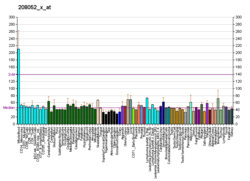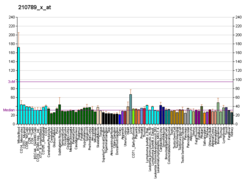| CEACAM3 | ||||||
|---|---|---|---|---|---|---|
| Идентификаторы | ||||||
| Символы | CEACAM3, CD66D, CEA, CGM1, W264, W282, carcinoembryonic antigen related cell adhesion molecule 3 | |||||
| Внешние IDs | HomoloGene: 130497 GeneCards: 1084 | |||||
| Профиль экспрессии РНК | ||||||
  | ||||||
| Больше информации | ||||||
| Ортологи | ||||||
| Виды | Человек | Мышь | ||||
| Entrez |
| |||||
| Ensembl |
| |||||
| UniProt |
| |||||
| RefSeq (мРНК) |
| |||||
| RefSeq (белок) |
| |||||
| Локус (UCSC) | Chr 19: 41.8 – 41.81 Mb | n/a | ||||
| Поиск PubMed | n/a | |||||
| Викиданные | ||||||
| Просмотр/Править (Человек) | ||||||
CEACAM3 (англ. Carcinoembryonic antigen-related cell adhesion molecule 3; CD66d) — гликопротеин семейства раково-эмбриональных антигенов (CEA), продукт гена человека CEACAM3[1].
Функции
Белок является основным рецептором гранулоцитов, который опосредует эффективный опсонин-независимый фагоцитоз CEACAM-связывающих микроорганизмов, включая Neissiria, Moxarella и виды Haemophilus. Таким образом, CEACAM3 играет важную роль в клиренсе патогенов во врождённой иммунной системе. Отвечает за стимуляцию RAC1 в процессе фагоцитоза патогенов.
Тканевая локализация
CEACAM3 экспрессирован исключительно на гранулоцитах и используется как маркёр этих клеток.
Взаимодействия
CEACAM3 взаимодействует с S100A9 белкового комплекса кальпротектина. Взаимодействие — Ca2+-зависимое, но не зависит от фосфорилирования CEACAM3.
Примечания
Литература
- Khan WN, Frängsmyr L, Teglund S, et al. (1992). “Identification of three new genes and estimation of the size of the carcinoembryonic antigen family”. Genomics. 14 (2): 384—90. DOI:10.1016/S0888-7543(05)80230-7. PMID 1427854.
- Kuroki M, Arakawa F, Matsuo Y, et al. (1991). “Molecular cloning of nonspecific cross-reacting antigens in human granulocytes”. J. Biol. Chem. 266 (18): 11810—7. PMID 2050678.
- Thompson JA, Mauch EM, Chen FS, et al. (1989). “Analysis of the size of the carcinoembryonic antigen (CEA) gene family: isolation and sequencing of N-terminal domain exons”. Biochem. Biophys. Res. Commun. 158 (3): 996—1004. DOI:10.1016/0006-291X(89)92821-0. PMID 2537643.
- Watt SM, Fawcett J, Murdoch SJ, et al. (1994). “CD66 identifies the biliary glycoprotein (BGP) adhesion molecule: cloning, expression, and adhesion functions of the BGPc splice variant”. Blood. 84 (1): 200—10. PMID 8018919.
- Nagel G, Grunert F, Kuijpers TW, et al. (1993). “Genomic organization, splice variants and expression of CGM1, a CD66-related member of the carcinoembryonic antigen gene family”. Eur. J. Biochem. 214 (1): 27—35. DOI:10.1111/j.1432-1033.1993.tb17892.x. PMID 8508798.
- Skubitz KM, Campbell KD, Skubitz AP (1996). “CD66a, CD66b, CD66c, and CD66d each independently stimulate neutrophils”. J. Leukoc. Biol. 60 (1): 106—17. PMID 8699114.
- Streichert T, Ebrahimnejad A, Ganzer S, et al. (2001). “The microbial receptor CEACAM3 is linked to the calprotectin complex in granulocytes”. Biochem. Biophys. Res. Commun. 289 (1): 191—7. DOI:10.1006/bbrc.2001.5955. PMID 11708798.
- Skubitz KM, Campbell KD, Skubitz AP (2002). “Synthetic peptides from the N-domains of CEACAMs activate neutrophils”. J. Pept. Res. 58 (6): 515—26. DOI:10.1034/j.1399-3011.2001.00931.x. PMID 12005421.
- Strausberg RL, Feingold EA, Grouse LH, et al. (2003). “Generation and initial analysis of more than 15,000 full-length human and mouse cDNA sequences”. Proc. Natl. Acad. Sci. U.S.A. 99 (26): 16899—903. DOI:10.1073/pnas.242603899. PMC 139241. PMID 12477932.
- Booth JW, Telio D, Liao EH, et al. (2003). “Phosphatidylinositol 3-kinases in carcinoembryonic antigen-related cellular adhesion molecule-mediated internalization of Neisseria gonorrhoeae”. J. Biol. Chem. 278 (16): 14037—45. DOI:10.1074/jbc.M211879200. PMID 12571236.
- McCaw SE, Schneider J, Liao EH, et al. (2003). “Immunoreceptor tyrosine-based activation motif phosphorylation during engulfment of Neisseria gonorrhoeae by the neutrophil-restricted CEACAM3 (CD66d) receptor”. Mol. Microbiol. 49 (3): 623—37. DOI:10.1046/j.1365-2958.2003.03591.x. PMID 12864848.
- Schmitter T, Agerer F, Peterson L, et al. (2004). “Granulocyte CEACAM3 is a phagocytic receptor of the innate immune system that mediates recognition and elimination of human-specific pathogens”. J. Exp. Med. 199 (1): 35—46. DOI:10.1084/jem.20030204. PMC 1887732. PMID 14707113.
- Kimura K, Wakamatsu A, Suzuki Y, et al. (2006). “Diversification of transcriptional modulation: large-scale identification and characterization of putative alternative promoters of human genes”. Genome Res. 16 (1): 55—65. DOI:10.1101/gr.4039406. PMC 1356129. PMID 16344560.
- Gimbergues P, Dauplat MM, Cayre A, et al. (2007). “Correlation between molecular metastases in sentinel lymph nodes of breast cancer patients and St Gallen risk category”. Eur J Surg Oncol. 33 (1): 16—22. DOI:10.1016/j.ejso.2006.09.013. PMID 17071045.
- Gasser M, Gerstlauer C, Grimm M, et al. (2007). “Comparative analysis of predictive biomarkers for therapeutical strategies in colorectal cancer”. Ann. Surg. Oncol. 14 (4): 1272—84. DOI:10.1245/s10434-006-9155-0. PMID 17211733.
- Howell NR, Zheng W, Cheng L, et al. (2007). “Carcinomas of ovary and lung with clear cell features: can immunohistochemistry help in differential diagnosis?”. Int. J. Gynecol. Pathol. 26 (2): 134—40. DOI:10.1097/01.pgp.0000233166.56385.d0. PMID 17413979.
- Stern-Ginossar N, Nedvetzki S, Markel G, et al. (2007). “Intercellular transfer of carcinoembryonic antigen from tumor cells to NK cells”. J. Immunol. 179 (7): 4424—34. DOI:10.4049/jimmunol.179.7.4424. PMID 17878338.
Данная страница на сайте WikiSort.ru содержит текст со страницы сайта "Википедия".
Если Вы хотите её отредактировать, то можете сделать это на странице редактирования в Википедии.
Если сделанные Вами правки не будут кем-нибудь удалены, то через несколько дней они появятся на сайте WikiSort.ru .